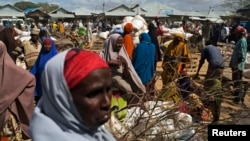The World Food Program has been struggling to find funds to feed half a million Somali and Sudanese refugees who are crammed into two large refugee camps in northern Kenya. The potential for unrest and humanitarian crises loom large in East Africa as the world donor community faces multiple high-cost emergencies around the globe.
The number of displaced people around the world hit record numbers in 2014, and donor nations are beginning to crack under the pressures of trying to cope with humanitarian crises in Iraq, Syria, the Central African Republic, Ebola-affected countries in West Africa, and refugees from Southern Sudan and Somalia.
In Kenya, a lack of donor funds has forced the World Food Program [WFP] to cut food rations in half for the nearly 500,000 Somali and South Sudanese living in refugee camps in the north of the country, said Challiss McDonough, senior spokeswoman for the WFP in East and Central Africa.
"The global humanitarian needs are just so enormous and have been growing so quickly that they have really outstripped the humanitarian funding that's available to support both those and other existing crises such as the refugee caseload in Kenya," said McDonough.
Major contributions
In recent days, the United States, Britain, Denmark and Germany have stepped in to fill the funding gap. McDonough said those contributions will allow WFP to gradually reduce the ration cuts and get the refugees back to full rations by February, but she warned that more needs to be done.
"The situation is still relatively tenuous in terms of the food we would then have available from March or April onward, so the crisis is abating for now, but it's not gone. Basically, we require $10 million a month to be able to feed the refugees in Kenya, and we need that month in, month out, until the political crises mainly in Somalia and South Sudan have been solved," she said.
According to the United Nations, 2014 saw some 52 million people displaced around the world.
Catherine Wiesner, U.S. deputy assistant secretary of state in the Bureau of Population, Refugees, and Migration, said reduced rations in Kenya will affect not only the mental and physical health of the refugees, but also their potential safety.
"We've seen insecurity in some of the refugee camps already. It's exacerbated some of the ethnic tensions, and other issues in the camp, and broadly, as you say, the concern would be that the government of Kenya and other refugee hosting nations would be forced to make decisions about whether to keep their borders open and whether they can continue to host so many people in their country," said Wiesner.
Security issues
WFP's McDonough said the organization is conscious of the tenuous security situation in the camps.
"We have been talking to the refugee leaders and the refugees themselves and trying to explain as clearly as possible that we do hope this is temporary, that this is not part of any concerted effort to force them to go back home," said McDonough.
The United States, which stepped up with $20 million to address the funding shortfall in Kenya, said it is working with U.N. agencies and host nations to decrease the reliance of refugees on aid by allowing them to work and grow crops.








